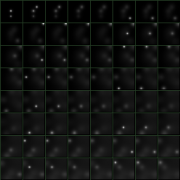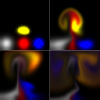I started over and now use an almost 1:1 copy for my C# implementation (it really was a bad idea to switch language and refactor at the same time). Even then I encountered similar problems - until I found my stupid bugs. Now it seems to work, so on your side, Toorop, I definitively suspect either a quirk with the SWAP or something going wrong with handling your input (sources) rather than some physics going wrong. I can turn off/on the advection like you did - and/or even the whole velocity step - I get the same results as long as there are no forces added: Here I "drop" density at a random point every 4th frame (read left-to-right, top-to-bottom):

Can you post your whole (relevant) code, please ?




